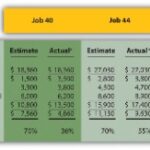These expenses might be of low value individually but can add up quite easily. For SMEs and startups, it is imperative to capitalize on the tax deductibility factor and ensure that they can earn as many savings as possible. Keeping track of business expenses can seem overwhelming, especially with the many expense categories available on tax returns.
- When assigning an expenditure, remember that it should be directly tied to the operation of your company.
- Please be aware that the cost of envelopes and packing should not be included since they are considered office supplies.
- Many businesses outsource some tasks because they lack in-house capabilities.
- Your marketing expenditure will include not just paying for marketing personnel, which will fall under payroll.
- The deduction for entertainment costs was, however, removed by the Tax Cuts and Jobs Act of 2017.
Bench and Square assume no liability for actions taken in reliance upon the information contained herein. You can categorize the premiums you pay for general liability, professional indemnity, and other types of insurance here. You can categorize expenses on computers, laptops, mobile phones, printers, and other equipment you use in the course of work. Use this category for making payments into a business retirement plan, like a 401(K).
Employee and Client Gifts
For instance, in December of 2019, you receive a bill from Atlas Roofing for repairs completed earlier in the month. How much risk you are willing to take will determine which of these you will go for, and how likely you are to need them, of course. But at the very least, categorizing them How To Categorize Expenses For Small Business separately can save you a lot of admin work. Your finance team should be able to access expense data whenever they want, without much labor. CRF, a national non-profit community development financial institution, is a leader in bringing capital to underserved people and communities.
Do you have to categorize business expenses?
It's crucial to categorize expenses the right way to keep your business in good financial shape. It helps you avoid IRS audits and penalties, leads to better budgets, and can even lower your taxes.
These twenty categories will likely cover most of the expenses incurred by an average small business. You will want to define your own categories for any spending that falls outside what we’ve listed above. Use this for online and offline advertising, sponsorships, https://kelleysbookkeeping.com/3-common-types-of-manufacturing-costs/ public relations, and similar fees. If you travel for business, and you haven’t categorized your spending elsewhere, you can include it here. This might include repainting, replacing lightbulbs, cleaning, repairing equipment, and other similar expenses.
Get back your time and money during tax season with Ramp
Below is an example small-business expense categories list that applies to most companies, outlining what’s included and how you can qualify for a deduction. Add to this industry-specific categories, such as R&D costs or spending to seek VC funding. You may benefit from utilizing these 10 deductions to lower your taxable income. Key deductions include those for home office expenses, health insurance premiums, and startup costs.

Payroll is an important category to consider given the sizable amount of finances that are dedicated to it. This could include wages, bonuses, or commissions that you pay workers, whether they’re full-time employees or contractors. Millions of companies use Square to take payments, manage staff, and conduct business in-store and online. This is a “catch-all” category for those miscellaneous office costs like postage, copier paper or toner cartridges, stationery, and similar expenses.
Use accounting software (or outsource your bookkeeping)
Allowable deductions must be directly related to getting the business up and running and organizational in nature, such as training staff and incorporation fees. You may be able to deduct up to $5,000 for startup and an additional $5,000 for organizational costs. For example, say you’re putting 250 miles per week on your private vehicle to get products out to customers. It may seem time-consuming to keep a log separating business and personal use, but you’re losing out on close to $600 in deductions. Or maybe you shuttered your office and started running your company from a spare room. As long as the space is exclusively used for business, you can deduct $5 for every square foot, up to $1,500.

In essence, tax-deductible business expenses can reduce the amount of taxes you have to pay for operating and profiting from your business. Creating business expense categories helps you understand which expenses you can deduct and which you can’t. In addition, if you have a bookkeeper or tax preparer handle your taxes, categorizing your expenses using a chart of accounts saves time and money on income tax preparation. Accounting software also helps you to use the data from your expenses to run profit and loss reports.

